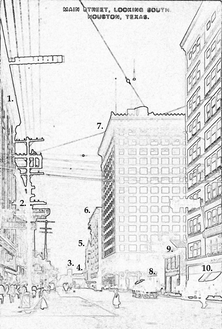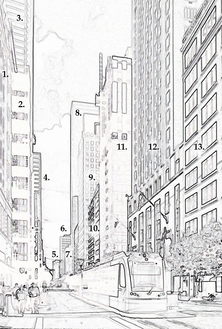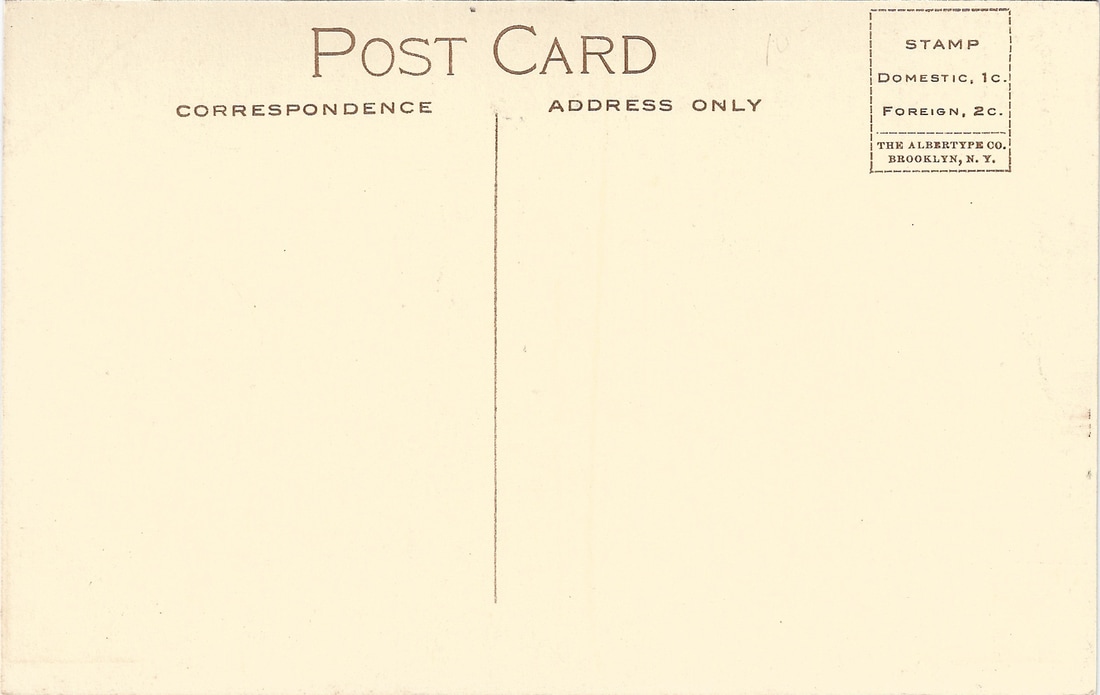Carter Building

Date believed to be 1911. The Carter Building, Methodist Church, and Texas Company were built in 1910 / Stowers Furniture destroyed in a fire May 19, 1912. 1. 701-703 Main: The white building at left corner was the Stowers Furniture Store, 7 floors / 705-709 Main: A. Lipper Womens Wear Shop; 2. 709-711 Main: Thomas Goggan & Bros. Pianos / 717 Main: The Mason Block Building upper floor tenants included: Allison-Richey Land Company / O'Nelii Millinery Co. / 719 Main: Anderson's Pharmacy; 3. Main 1320: First Methodist Church, 1910; 4. 820 Main: Construction shed in front of the Bender Hotel, construction ended 1909; 5. 920 Main: First Presbyterian Church, 1896 (burned to the ground in 1932); 6. 820 Main: Bender Hotel built by life-time bachelor Eugene Leon Bender (1868-1934), 12 floors, 1911 in the final stages of construction; 7. 806 Main: The Carter Building built by Samuel Fain Carter (1857-1928), 17 floors, 1910; 8. 718 Main: The boarding house of Mrs. Mary L. Jones, once the home of Charlotte Baldwin Allen “The Mother of Houston (1805-1895), wife of Houston's founder, Augustus Chapman Allen, built about 1850, demolished 1915 [See Main Capitol – Jones for a view after the block was commercially developed]; 9. 716 Main: George Slimpin Gas Fitter / Mrs. Francis Rawls (boarding house); 10. 712 Main: The Texas Company, 10 floors, 1910.
For a view of this first block from the south at about this same time see Main Rusk North. The neighborhood further south at this time was largely residential. |

6 September 2013: 1. Main 705: St. Germain Loft apartments (S. H. Kress), 8 floors, 1913; 2. 711 Main: Capitol Lofts with their projecting balconies, 10 floors, built in 1908 as the M. E. Foster Building; 3. 811 Main: BG Group Place (Main Place), 46 floors, 2011; 4. 1001 McKinney: City National Bank building, 22 floors, 1947-9 / 1021 Main: One City Centre (First National Bank), 32 floors, 1961; 5. 2016 Main: 2016 Main Condominium Tower (built on the site of the Abe Levy mansion), 26 floors, 1965 / 1900 Main: Lee P. Brown Metro Administration Building, 14 floors, 2005 / 1616 Main: Holiday Inn Downtown Houston (Savoy Field Hotel), 17 floors, 1966 (renovated 2015); 6. 1300 Main: Travis Tower (Conoco Building), 21 floors, 1955; 7. 916 Dallas: Courtyard Marriott (Humble Building, renovated 2003 into a hotel), 9 floors, 1921; / 1110 Main: Macy's (Foleys), 6 floors, 1947 (in 1957 4 more floors were added)(imploded on 21 September 2013, 15 days after this photograph was taken) [replaced by Hilcorp Energy Tower 1111 Travis, 23 floors, 2016]; 8. 1000 Main: Reliant Energy Plaza, 36 floors, 2003; 9. 914 Main: Commerce Tower, 24 floors, 1929 (converted into condominiums 2003); 10. 820 Main: Walker @ Main Garage, 12 floors, 2007 / 812 Main: Battlestein's Building, 10 floors, 1923; 11. 806 Main: JW Mariott Houston (Carter Building), 23 floors, 1910 (6 more floors added in the 1920's), here in the process of renovation by the removal of the vertical cladding installed when the First National Life Insurance Company purchased the building in 1969; 12. 712 Main: Gulf Building, 36 floors, 1929; 13. 708 Main: The Great Jones Building, 10 floors, 1908 (expanded in 1921 when the building was extended to the corner of Capitol Street).
|
|
The Carter Building was by far the tallest building in town, quickly dubbed “Carter’s Folly” because many believed that it was bound to be unstable. No building up to that time had more than 9 floors, but Carter countered these criticisms with another 6 floors in 1925. Tenants in 1911 included Samuel Fain Carter, who built the structure and his brother Joseph Presley Carter, Ross S. Sterling, a hay and grain merchant who would become the 31st governor of Texas (1931-1933) and a founder of Humble Oil Company, real estate companies including Magnolia Park Land Company, Sylvan Beach Land Company, and Clifton-By-the-Sea Townsite Company, various attorneys and other professionals.
The Texas Company Building was built by Houston’s most important developer, Jesse Holman Jones. He was one of the founders of an oil company initially funded by the Spindletop strike, later to become one of the world's largest oil companies, Texaco. Tenants at the time included the sales floor for J. W. Carter music company (James W. Carter was no apparent relation to Samuel Fain Carter); William Clifford Hogg and the estate of his father, James Stephen Hogg, the 20th governor of Texas (1891-1895); Howard Robard Hughes, Sr. and Walter B. Sharp of Sharp Hughes Tool Company, patented owners of a rotary drill bit that revolutionized oil drilling . |
Samuel Fain Carter built the 16-story Carter Building in 1910 despite jeers that construction so high on such unstable foundations would become “Carter’s Folley.” No building up to that time had more than 9 floors, but Carter countered these criticisms with another 6 floors in 1925. Tenants in 1911 included Samuel Fain Carter, who built the structure, his brother Joseph Presley Carter, as well as Ross S. Sterling, a hay merchant and founder of Humble Oil Company who would become the 31st governor of Texas (1931-1933). Other tenants included real estate companies such as Magnolia Park Land Company, Sylvan Beach Land Company, and Clifton-By-the-Sea Townsite Company, and various attorneys and other professionals. Carter’s business partner and fellow lumberman, Jesse Holman Jones, built the neighboring Texas Company Building (at far right). Jones had diversified his holdings after the Spindletop strike and became one of the founders of the oil company later to become one of the world's largest oil companies, Texaco. Tenants at the time included 1st floor J. W. Carter music company (James W. Carter was no apparent relation to Samuel Fain Carter); William Clifford Hogg who managed the estate of his father, James Stephen Hogg, the 20th governor of Texas (1891-1895). Another tenant was Howard Robard Hughes, Sr. and Walter B. Sharp of Sharp Hughes Tool Company, patented owners of a rotary drill bit that revolutionized oil drilling.
S. F. Carter was the son of John Quincy Adams Carter (1830-1894) and Mildred Ann Richards (1835-1908), who moved from Huntsville, Madison County, AL to Sherman, TX when Samuel was a one year old. He was schooled in Sherman until he was 14, working as an apprentice typesetter for the Sherman Courier. At 19 he found prestigious work for the Galveston Daily News and relocated there until he was 23. In 1882 he married Carrie Banks, 24-year-old daughter of John Baylor Banks, an early immigrant to the Republic of Texas, and a member of the Texas State Legislature from Travis County 1853-1855. Banks moved to Galveston by 1870, and died there in 1874, but his remains were washed away in the 1900 storm. Abandoning printing as a career about 1880, he became a bookkeeper for a Beaumont lumber company and learned as much as he could about the lumber business. In 1892 he moved to Houston to become the Vice President of M. T. Jones Lumber Company [see LINK], later to become Jones & Carter; after the death of Martin Tilford Jones in 1898, the company was renamed the Emporia Lumber Company, an increasingly successful enterprise. The lumber business made the fortunes of several Houstonian millionaires, and S. F. Carter joined their ranks in 1906 when he sold out his lumber business for a million dollars. He took his fortune and forged a third career, that of real estate developer, builder and banker. He bought a lot at the corner of Main and Rusk in a part of town far south of the centers of business and there he built his namesake building, drawing commerce to his new beachhead. As banker he had organized the Lumberman’s Bank in 1907 from a small building on Franklin, moving a few years later to a three-story structure at the northwest corner of Main and Prairie, the Prince Building [LINK Audrey Lewis Preston and Fannin]. Samuel Fain Carter died 1 March 1928 and Carrie died 12 April 1942 leaving 3 daughters (Clara Roos 1882-1965, Florence Ella Bryan 1884-1967, and Annie Vive Crain 1891-1940) and a son Samuel Fain Carter, Jr. (1890-1928); all are buried in a splendid marble family plot in Glenwood Cemetery in Houston |

